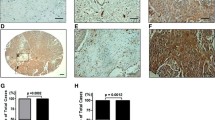Summary
Membrane-type 1 matrix metalloproteinase (MT1-MMP/MMP-14) plays crucial roles in tumor cell growth, invasion, and angiogenesis. To clarify whether the endogenously expressed MT1-MMP in metastatic human ovarian carcinoma cell lines SKOV3 plays a critical role in tumor cell invasiveness, antisense MT1-MMP cloned in cukaryotic expression vector pMMP14as was transferred into SKOV3 cells. 48h after transfection, decreased expression of endogenous MT1-MMP protein was detected in pMMP14as-transfected SKOV3 cells and the activation of pro-MMP2 was inhibited markedly. The mean percentage of invasive cells was (62.50±5.30)% in pMMP14as-transfected cells, which was obviously less than that (97.20±6.90) % in the control. Thus, antisense MT1-MMP effectively inhibited the endogenous MT1-MMP expression and the invasiveness in SKOV3 cells, suggesting that MT1-MMP may be a therapeutic target molecule for human invasive ovarian cancers.
Similar content being viewed by others
References
Sounni N E, Devy L, Hajitou Aet al. MT1-MMP expression promotes tumor growth and angiogenesis through an up-regulation of vascular endothelial growth factor expression. FASEB J, 2002, 16(6):555
Rozanov D V, Savinov A Y, Golubkov V Set al. Cellular membrane type-1 matrix metalloproteinase (MT1-MMP) cleaves C3b, an essential component of the complement system. J Biol Chem, 2004, 279(45):46551
Heussen C, Dowdle E B. Electrophoretic analysis of plasminogen activation in polyacrylamide gels containing sodium dodecyl sulfate and copolymerized substrates. Anal Biochem, 1980, 102(1):196
Graves L E, Ariztia E V, Navari J Ret al. Proinvasive properties of ovarian cancer ascites-derived membrane vesicles. Cancer Res, 2004, 64(19):7045
Ueda J, Kajita M, Suenaga Net al. Sequence-specific silencing of MT1-MMP expression suppresses tumor cell migration and invasion: importance of MT1-MMP as a therapeutic target for invasive tumors. Oncogene, 2003, 22(54):8716
Seiki M. Membrane-type 1 matrix metalloproteinase: a key enzyme for tumor invasion. Cancer Lett, 2003, 194 (1):1
Hotary K B, Allen E D, Brooks P Cet al. Membrane type I matrix metalloproteinase usurps tumor growth control imposed by the three-dimensional extracellular matrix. Cell, 2003, 14(1):33
Hotary K, Allen E, Weiss S Jet al. Regulation of cell invasion and morphogenesis in a three-dimensional type I collagen matrix by membrane-type matrix metalloproteinases 1, 2, and 3. J Cell Biol, 2000, 149(6):1309
Stein C A, Cheng Y V. Antisense oligonucleotides as therapeutic agents is the bullet really magical. Science, 1993, 261(5124):1004
Author information
Authors and Affiliations
Additional information
WU Mingfu, male, born in 1972, M.D., Ph.D.
This study was sapported by grants from National Basic Research program “973” (No.2002CB513107).
Rights and permissions
About this article
Cite this article
Mingfu, W., Yanyan, S., Lin, X. et al. Construction of antisense MT1-MMP vector and its inhibitory effects on invasion of human ovarian cancer cells. J. Huazhong Univ. Sci. Technol. [Med. Sci.] 25, 715–717 (2005). https://doi.org/10.1007/BF02896180
Received:
Issue Date:
DOI: https://doi.org/10.1007/BF02896180




